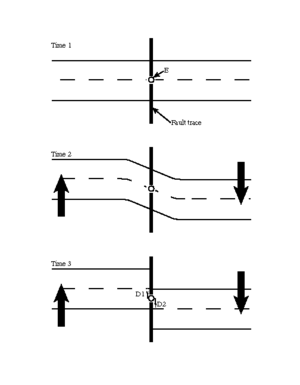Elastic-rebound theory facts for kids
The elastic-rebound theory helps us understand how energy is set free during an earthquake. Imagine the Earth's crust (its outer layer) slowly changing shape. Rocks on opposite sides of a fault (a big crack in the Earth) are pushed and pulled. They slowly bend and stretch.
This bending continues until the rocks can't hold on any longer. Then, they suddenly break and snap back into place along the fault. This quick movement releases all the stored-up energy. It's like stretching a rubber band until it breaks and snaps back. The energy travels through the ground as seismic waves, which we feel as an earthquake.
What is the Elastic-Rebound Theory?
After the huge 1906 San Francisco earthquake, a scientist named Harry Fielding Reid studied the ground. He looked at how the land had moved along the San Andreas Fault for 50 years before the quake. He found that the ground had bent about 3.2 meters (10.5 feet) during that time.
Reid realized that the earthquake happened because of this "elastic rebound." It was the sudden release of energy stored in the rocks on both sides of the fault. Later, scientists used GPS to measure ground movement. Their findings largely supported Reid's idea about how earthquakes happen.
How Does Elastic Rebound Work?
Imagine a road built straight across a fault line. The two sides of an active fault are always moving, but sometimes the fault gets "locked." This means the rocks are stuck together. As the Earth's plates continue to move, energy builds up in the rocks near the locked fault.
Think of it like this:
- Time 1: The road is straight across the fault. The fault is locked, so the rocks can't move past each other.
- Time 2: The Earth's plates keep moving slowly. This causes the rocks near the fault to bend and stretch. The road starts to curve because the ground is deforming. This bending can happen very slowly, maybe a few centimeters each year.
- Time 3: When the stored energy becomes too great, the rocks suddenly break. They quickly snap back to their original shape as much as possible. This sudden snap is what causes an earthquake. The road is now broken and shifted.
The energy released during this snap turns into heat, changes the rock, and creates seismic waves that shake the ground.


